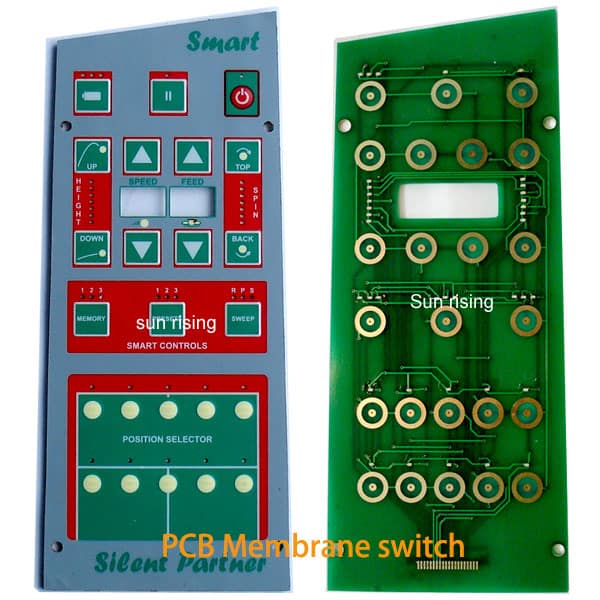The Main Benefits of Using Membrane Switches in Industrial Applications
Why Membrane Changes Are Vital for Sturdy Control Systems
Membrane buttons play a pivotal duty in ensuring the toughness and dependability of control systems throughout different industries. As we check out the complex benefits of membrane switches, it ends up being obvious that their value transcends plain functionality, influencing individual experience and operational effectiveness.
Introduction of Membrane Layer Buttons
Membrane buttons are functional and trusted elements frequently made use of in different electronic control systems. The graphic overlay provides both useful and visual style, while the spacer layer guarantees that the buttons are triggered just when pressed.
Membrane layer switches are frequently favored in applications needing a portable and light-weight design, making them suitable for handheld gadgets, clinical equipment, and industrial machinery. They can be tailored to fulfill particular customer needs and can incorporate numerous functions such as backlighting, responsive comments, and several colors. Membrane buttons are resistant to dirt, wetness, and pollutants, making them ideal for environments where durability is crucial.
Benefits of Durability
In several applications, the sturdiness of membrane changes deals substantial advantages that boost their general efficiency and reliability. These switches are created to hold up against harsh environments, making them optimal for usage sought after problems such as high humidity, severe temperature levels, and exposure to chemicals. Their robust building and construction aids to stop damage from physical impact, making certain resilient performance and minimizing the requirement for regular substitutes.
In addition, membrane switches are immune to wear and tear, which is essential in applications where regular communication happens. This sturdiness equates to lower upkeep costs, as organizations take advantage of reduced downtime and less solution disturbances. In addition, the encapsulated layout of membrane layer changes protects internal elements from dust and wetness ingress, more adding to their life expectancy.
One more advantage is their ability to maintain regular performance in time. With a high tolerance for mechanical anxiety, these switches preserve their tactile feedback and electrical honesty, guaranteeing customer complete satisfaction. Ultimately, the longevity of membrane changes not only boosts functional efficiency but likewise cultivates confidence in their dependability, making them a preferred choice for control systems across different fields.
Applications in Numerous Industries
Long lasting control systems utilizing membrane switches discover considerable applications throughout an array of industries, each benefiting from the distinct qualities these buttons provide. In the medical sector, membrane switches are essential for gadgets such as person displays and diagnostic tools, where reliability and convenience of cleaning are vital. Their resistance to dampness and contaminants ensures they maintain capability in clean and sterile atmospheres.
The auto sector leverages membrane switches for dashboard controls and infomercial systems, where they offer streamlined, inconspicuous interfaces that improve individual experience. These switches are additionally created to withstand extreme problems, including direct exposure to severe temperatures and vibrations.
In commercial setups, membrane switches are commonly utilized in machinery control board, using responsive feedback and toughness essential for high-usage applications. Their ability to resist chemicals makes them appropriate for producing settings where spills and pollutants are constant.

Consumer electronic devices, such as cooking area home appliances and push-button controls, additionally utilize membrane layer buttons for their convenience and cost-effectiveness. In general, the flexibility and robust nature of membrane layer switches over make them important across various fields, making certain reliable procedure and long life in control systems.
Layout and Aesthetic Charm
While functionality is vital, the design and visual allure of control systems outfitted with membrane switches play a vital duty in individual interaction and total experience (membrane switch). The aesthetic layout of these buttons can significantly influence user understanding and communication. A well-designed membrane switch improves the attractiveness of the gadget, making it extra enticing to individuals and promoting a connection between the user and the product
Membrane layer switches over use why not try these out a lot of versatility in design, enabling suppliers to personalize graphics, colors, and appearances to line up with brand name identification and item aesthetics. The use of vibrant colors and distinctive patterns can attract attention, while tactile comments can strengthen the user's interaction with the gadget. Furthermore, the capability to integrate LED indicators and backlighting right into the membrane switch style offers both functional and aesthetic benefits, boosting visibility and functionality in various environments.

Enhancing Customer Experience

Additionally, membrane layer buttons can be personalized to integrate visual interfaces, improving functionality by presenting information in a clear and intuitive manner (membrane switch). This customization can include symbols, labels, and color coding that guide users via complex functionalities easily. In addition, their convenience enables integration in various environments, guaranteeing regular efficiency whether in industrial machinery or customer electronic devices
The toughness of membrane layer buttons likewise plays an important function in user experience. By enduring harsh conditions and extended usage, these buttons minimize the likelihood of system failures, hence promoting dependability and user self-confidence. Eventually, the critical use membrane layer switches over not just boosts functionality however also significantly enhances individual communication with control systems, making them a crucial part in modern-day layout.
Conclusion
